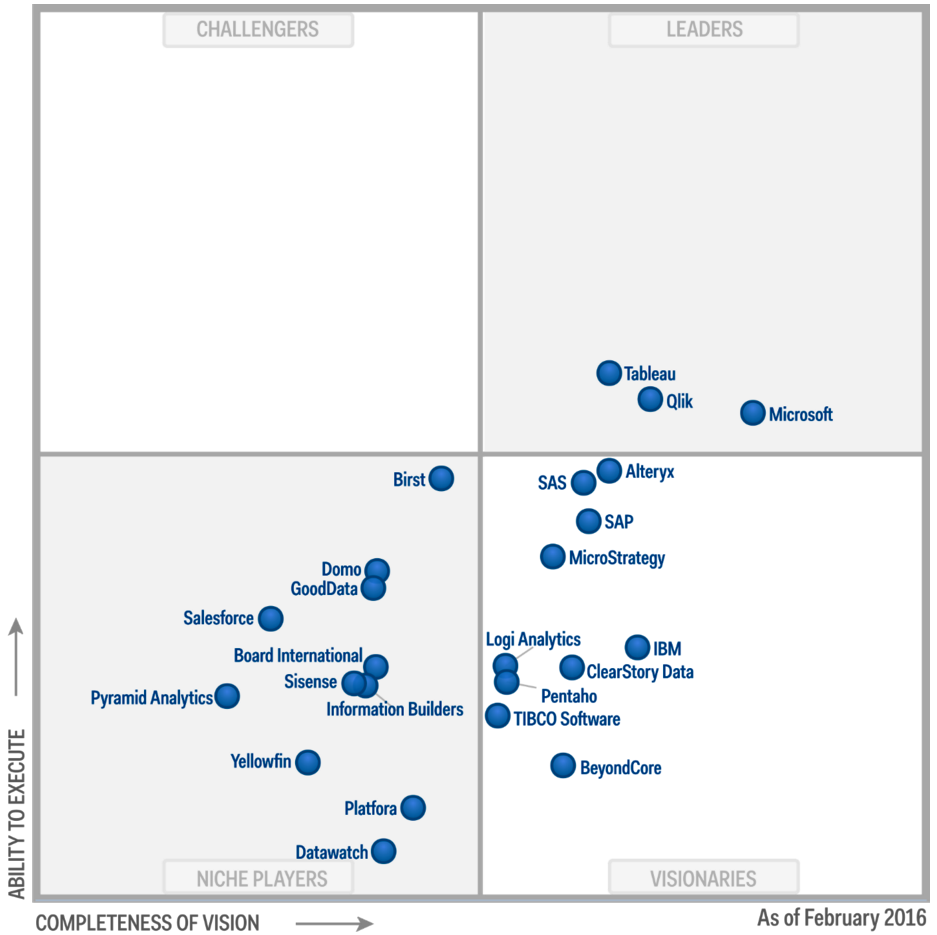
Tumultuous Times for BI and Analytic Tool Vendors

(jijomathaidesigners/Shutterstock.com)
My, what a week it was for business intelligence (BI) and analytic tools. First, industry darling Tableau Software (NYSE: DATA) lost half its market capitalization following earnings that disappointed Wall Street, which quickly punished competitors Qlik (NASDAQ: QLIK) and MicroStrategy (NASDAQ: MSTR). Gartner then added fuel to the fire by issuing a report finding more competition than ever in the space, thanks to the arrival of a tipping point in the drive to self-service tooling.
The balance of power in the BI and analytics space has been gradually shifting as providers of easy-to-use tools like Tableau and Qlik have gained market share at the expense of public companies like IBM (NYSE: IBM), SAP (NYSE: SAP) , and Oracle (NYSE: ORCL), as well as privately held stalwarts like SAS, Information Builders, and Tibco.
“This significant shift has accelerated dramatically in recent years and has finally reached a tipping point that requires a new perspective,” six Gartner analysts write in the latest Magic Quadrant for BI and Analytic Platforms. “Most new buying is of modern, business-user-centric platforms forcing a new market perspective, significantly reordering the vendor landscape.”
To that end, Gartner has dedicated its closely watched Magic Quadrant on the topic to focus entirely on these types of self-service BI tools that can be deployed without a lot of hand-holding by IT professionals or upfront work done to prepare the data for analysis.
Such tools are characterized by features such as agile provisioning (including via the cloud), decentralized analytics, governed data discovery, being embeddable, supporting unstructured data, delivering self-contained ETL, offering self-service data prep, supporting visual exploration, and including social collaboration and mobile support.
With these guideposts in mind, a total of 24 vendors made Gartner’s final cut for the Magic Quadrant, the same number as last year, but three fewer than in 2014. But the big news is the culling of the Leader’s Quadrant.

Gartner’s 2016 Magic Quadrant for Business Intelligence and Analytics Platforms
Last year’s report featured nine vendors in the Leader’s Quadrant, but only three made the cut this year. Sent packing from the prestigious perch were MicroStrategy, Oracle, IBM, SAP, and SAS, each of which you can now find in the Visionaries’ quadrant, thanks to lower abilities to execute compared to last year. And Info Builders lost even more cred, falling into the Niche Players category after scoring lower in ability to execute (Y axis) and completeness of vision (X axis).
That leaves only Tableau, Qlik, and Microsoft (NASDAQ: MSFT) in the leader’s quadrant this year. Tableau is still the overall leader in the space, according to Gartner, but its lead has shrunk dramatically over the past year. Qlik still lacks some of the capabilities of Tableau, but is closing the gap with a “rapid cadence” of releases, most recently around Qlik Sense, the analyst firm says.
The big winner is Microsoft, which emerged from a crowded pack of BI and analytic tool providers to become a leader in the space thanks to a big rise in its completeness of vision, according to Gartner. (Nearly all vendors suffered losses on the ability to execute axis, according to the report).
Microsoft clearly impressed Gideon’s firm with PowerBI, its new flagship analytic offering that costs users just $10 per month. It seems particularly pleased with the software giant’s product roadmap, which includes future features like natural-language query and generation via Cortana, which is Microsoft’s version of Apple’s Siri. Data monetization, a cloud-based business model, user enablement, and a wide variety of data connectors helped plump up its score.
Among the new breed of analytic providers getting traction in the Visionaries Quadrant were Alteryx, which continued to impress Gartner, largely due to its self-serviced data prep capabilities and product vision. ClearStory Data also turned some heads in Stamford, Connecticut thanks to its “data inference” and data integration capabilities, while BeyondCore‘s smart pattern detection and natural language generation were noted.
No fewer than 11 vendors occupied the crowded Niche Players quadrant, including Salesforce, Domo, Sisense, and Platfora, all of which were included in the report for the first time. Gartner particularly liked the governed data discovery capabilities of Birst, the strategic alignment that Pyramid Analytics has to Microsoft (it developed its PowerBI Desktop offering), and the centralized provisioning and collaboration of Yellowfin BI. Platfora got the nod for its interactive visual exploration atop a Hadoop-based platform, while Datawatch continued to impress with its visual data discovery capabilities.

Tableau’s stock lost nearly half its value Feb. 5 following the release of quarterly results
One of the interesting trends in this year’s Magic Quadrant (aside from the fact that Gartner completed rejiggered the formulas to favor products that deliver the aforementioned features in an easy-to-use, Tableau-ish manner) is the emergence of the cloud-based delivery models. Birst, GoodData, Domo and Salesforce are among the pure-play cloud providers getting a seat on Gartner’s Magic Quadrant bus this year. All of them are included in the Niche Players quadrant.
Clearly, this is a good time to be a buyer of BI and analytic tools, even if it’s not such a good time to be a vendor (see: the market cap drops of Tableau, et. al.) As the big data wave continues to crest, organizations are demanding easier ways to extract valuable information, and vendors are responding with increasingly sophisticated capabilities. Not every legacy BI tool needs to be ripped out and replaced, but clearly there is a replacement cycle occurring, and customers stand to be the big benefactors.
Related Items:
Tech ‘Democratization’ Seen Fueling Analytics Boom
Rating the Advanced Analytics Vendors
SAS and IBM King of Analytics Hill, But for How Long?



























